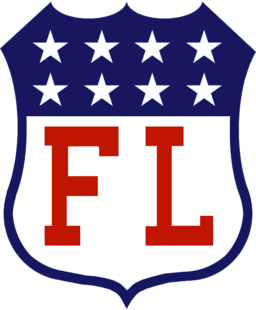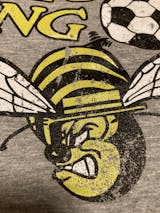The National Football League (NFL) has faced many contenders for the hearts and minds of gridiron fans. Since its inception in 1920 as the American Professional Football Association (it became the National Football League in 1922), it has faced six serious contenders. It vanquished four of them, took three teams out right from one, and completely absorbed another.
Meanwhile, Major League Baseball (MLB), made up of the American and National Leagues, has only been challenged twice. One rival, the Federal League, lasted three seasons, while the other, the Continental League, never played a game. the latter did have an impact on MLB though.
The Federal League (1913-1915)
The National League (officially the National League of Professional Baseball Clubs) or NL was formed in 1876 and his home to the sport’s oldest professional team, the Cincinnati Reds. The American League, or American League of Professional Baseball Clubs (AL), came along in 1901 having grown out of the minor Western League which had been operating since 1885 and was primarily concentrated in the Great Lakes region.
In 1902, the two leagues began a collaboration but remained separate entities until 2000 when they officially became one organization. In 1903, the champions of the two leagues, the Pittsburgh Pirates of the NL and the Boston Americans (later Red Sox) of the AL met in the first World Series. The 1904 series was not played as the New York Giants ownership and management famously declined to play against the inferior American League, citing that they were already champions of the only major league.
Things were sorted for the following season, and the series has been played every year since, except for 1994 due to a player’s strike. The issues of money and player signings settled, the two leagues, with eight teams each, coexisted peacefully and it was smooth sailing for professional baseball-- until 1913.
Formed by John T. Powers the Federal League (FL) was formed. The new circuit was immediately attractive to players as it had no reserve clause as the other two leagues did. In other words, players could move from team to team and weren’t contractually bound to a particular club in a deal that could only be terminated by the team.
Powers was in charge of the league in its first season with teams in Chicago, Cleveland, Covington, KY, Indianapolis, and St. Louis. He was replaced for the 1914 season by James A. Gilmore who immediately declared the FL a major league. Having signed away several top players from the NL and AL, this claim was just, though only truly recognized posthumously by baseball historians. Major League Baseball at the time considered the Federals to be an “outlaw league.”
For its first major league season in 1914, the FL matched the number of AL and NL teams with eight. The Federals played in Chicago, St. Louis, Pittsburgh, and Brooklyn, all of which had a team in one or both of the established leagues. The FL also placed teams in Baltimore, Buffalo, Indianapolis, and Kansas City bringing major league baseball to four cities that did not have a professional team. The Indianapolis Hoosiers won the 1914 FL pennant.
After the 1914 season, the Federal League pioneered the strategy of suing the existing league on antitrust grounds, something that would be attempted later by two of the NFL’s rivals. The case lingered though, with Judge (and later commissioner of baseball) Kenesaw Mountain Landis pushing for a negotiated settlement. The delay hastened the financial distress of the Federal League teams. At the conclusion of the 1915 season, owners in the AL and NL bought out 4 of the FL teams, Brooklyn, Buffalo, Newark, and Pittsburgh. Two FL owners were encouraged to buy struggling teams in the established leagues, the St. Louis Browns in the American and the Chicago Cubs in the National, both purchased by the owners of the local Federal League teams, with rosters merged.
The Cubs not only acquired players from the former Chicago Whales (the 1915 FL pennant winners) but that team’s stadium as well. The Cubs moved into the Whale’s former home, Weeghman Park (later Wrigley Field), in 1916, after having played 30 years at West Side Park.
The league’s other legacy came from a lawsuit but not the one filed by the league itself against the AL and NL. A suit brought by the Baltimore Terrapins, and not settled until 1922, found pro baseball exempt from antitrust laws, a status not granted to other pro sports. Thus, the NFL had to deal with many challengers while Major League Baseball did not. However, in 1959 that changed.
The Continental League (1958-1960)
Through the early 1950s, pro baseball was confined to the Northeast and Midwest, and while there were 16 pro teams, five cities had more than one team, with New York claiming 3. In 1953, the Boston Braves moved to Milwaukee and the following season, the St. Louis Browns moved to Baltimore to become the Orioles. In 1955, the Philadelphia Athletics moved to Kansas City. Still, neither league had a team in the south or west.
That changed in 1956 when two of the New York area teams, the Giants and the Brooklyn Dodgers moved to San Francisco and Los Angeles respectively. The idea that teams could be placed in markets outside of the Midwest and Northeast, combined with New York market having only one team, where it once supported three, created a huge opportunity.
New York attorney William Shea (for whom Shea Stadium was named), came up with the idea for the Continental League in the fall of 1958, with the formal announcement coming on July 27, 1959. The league was scheduled to begin play in the spring of 1961. New York City, Toronto, Denver, Minneapolis, and Houston were named as CL cities, with the expected addition of Dallas/Ft. Worth, Atlanta, and Buffalo. Former Brooklyn Dodger executive Branch Rickey, who had been appointed president of the league, appeared on the CBS game show What’s My Line? After revealing his identity and occupation he announced the league’s existence as a certainty.
Many believed that the Continental League was simply a bluff put forth by Shea to bring another baseball team to New York to replace the Dodgers and Giants, either by expansion or the relocation of an existing team. In the fall of 1959, though, he said “we checked into expansion of the current leagues. There’s not a chance of that.” adding “they need a unanimous vote of league owners to expand to 10 teams, and they’ll never get it.”
However, the AL and NL owners did take action, awarding expansion teams to Houston in the National League and Washington in the American League, the latter to replace the Senators who had announced a move to Minneapolis at the conclusion of the 1960 season to become the Minnesota Twins. A National League team was then announced for New York and offered to the Continental League’s ownership group who gladly accepted. The American League awarded a franchise to Los Angeles. The formation of these four teams effectively killed the Continental League, and in August of 1960, it was dissolved.
Eventually, every proposed CL city except Buffalo would get a Major League Baseball team, though for some it would take more than 30 years, in the case of Denver, for example.
And while baseball, historically reluctant to expand and divvy up its lucrative, antitrust-proof pie, would have been forced to expand at some point, the threat of the Continental League probably expedited the addition of new teams by several years.
As a side note, three major leagues predate the American League, starting with the American Association from 1882 to 1891, the Union Association (1884), and the Player’s Association in 1890. The National League and American Association attempted a World Series of sorts in the 1880s before the former absorbed the latter to form a 12-team National League. After the 1899 season, four teams, Cleveland, Washington, Baltimore, and Louisville were dismissed from the league, a move that helped in the eventual formation of the American League.





